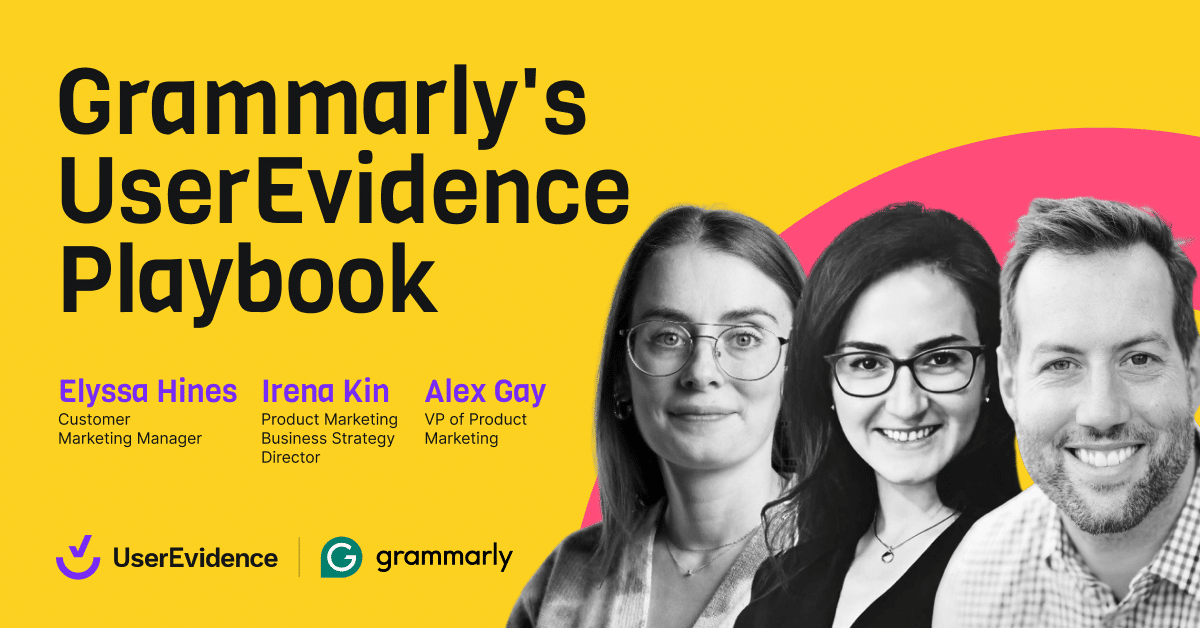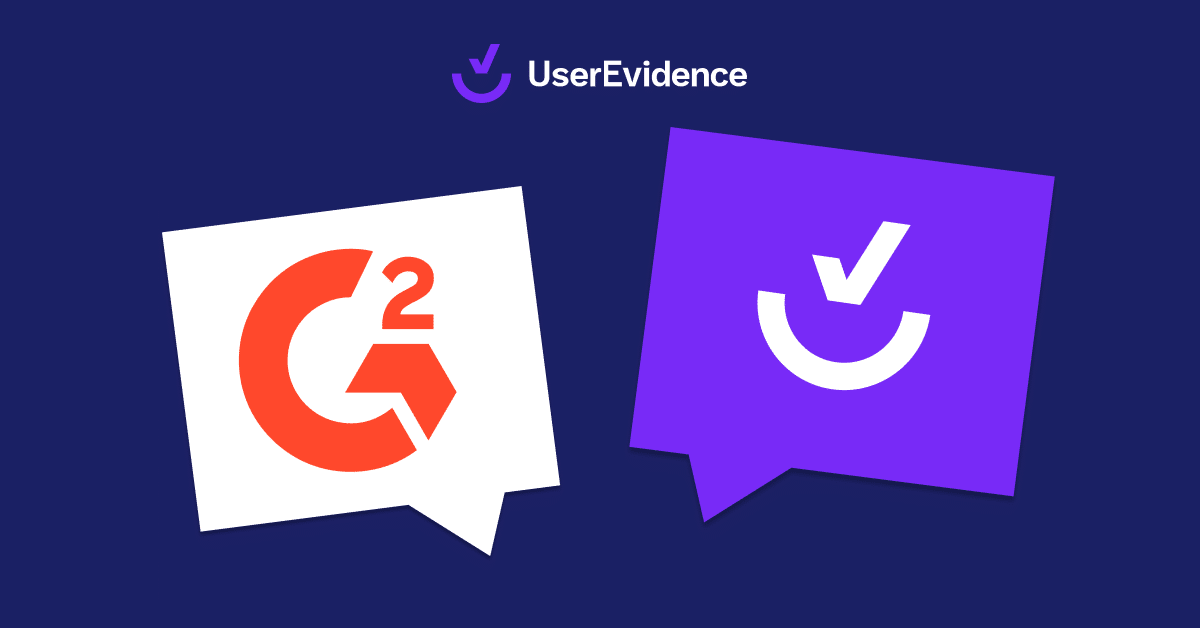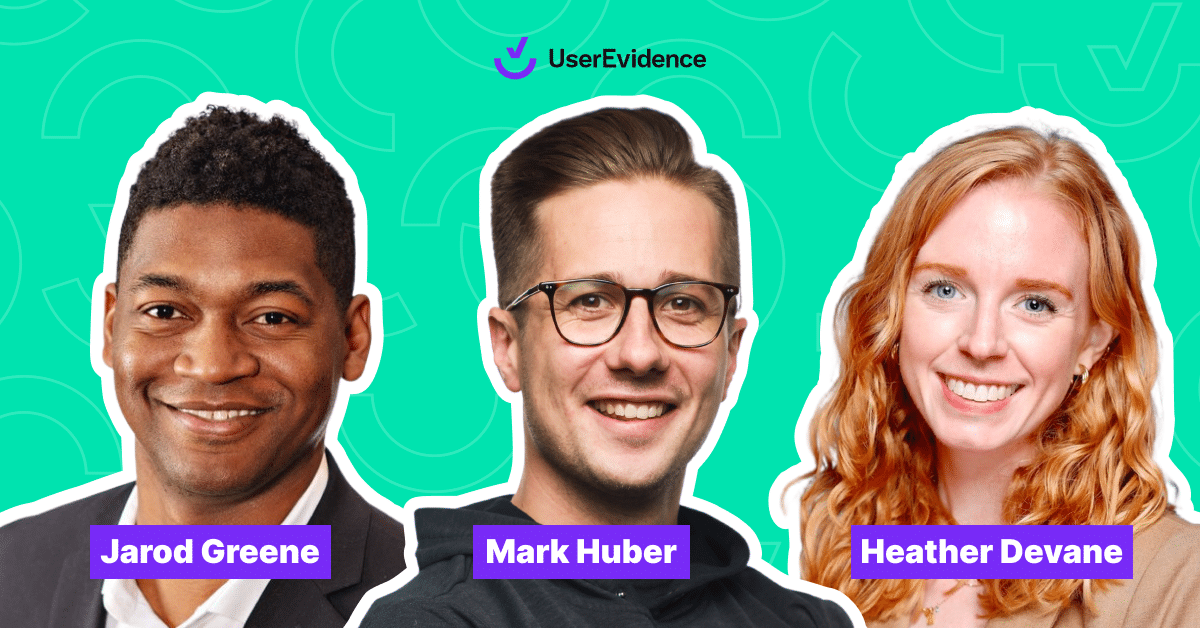Picture your social media feed — a friend’s month-long trip to Europe, your cousin’s destination wedding, that coworker moving into their dream home.
Those snapshots look glamorous and effortless, right?
The truth is, a ton goes on behind the scenes: to-do lists, spreadsheets, and coordination with a whole team of people.
In every corner of our lives, the planning process matters just as much as the execution, whether we’re talking about our biggest adventures or capturing customer feedback at work.
Surveys are the perfect tool for gathering customer insights — as long as you’re intentional from day one. Here’s what UserEvidence CEO and Co-founder Evan Huck had to say:
I wanted to know what prep work goes into building an impactful survey (that gets meaningful results), so I sat down with three people who know a ton about survey design to pick their brains.
Evan, Chief Product Officer and Co-founder Ray Rhodes, and VP of Customer Success Myles Bradwell shared their thoughts on what should happen behind the scenes before you ever ask a question.
The three of them came to a consensus: Answer these nine questions as a team before you ask your customers anything.

Question 1: What do we want to accomplish?
According to Myles, companies often take a generic approach to surveying, like using a template they found online. Here’s how that typically turns out: “At the end, they say, ‘I should have thought of what we actually wanted to produce and who this was going to,’” he explains.
Instead of jumping straight to asking questions, Evan encourages teams to think about surveys as a way to have a structured feedback conversation at scale. That definition directs the focus of the survey toward accomplishing a goal, not just for one team but for the entire GTM organization.
Because, let’s be real, each team needs customer feedback — Marketing, Sales, CS, and Product — but they all view that feedback differently. Consider upfront which functions will use the data and how the survey data can help them, so you can survey to meet those needs.
Not sure where to start?
Start by defining the story you want to tell, the claims you want to make, and the output you want to create. These goals will inform the survey questions you ask and how you ask them.
When you begin with the end in mind, the survey creation and distribution processes go more smoothly and your final product matches your goals.
Question 2: Who will we survey?
Even the best survey in the world is pointless if you send it to the wrong people.
So, define your audience and curate your list based on agreed-upon criteria. The answer might be your current customers, potential customers, or future users of an upcoming feature.
Look back at your answer to Question #1. That story you wanted to tell? These are the people you want to hear that story from.
You should also address how you’ll segment the customer’s survey experience, especially if your customer base includes lots of functions. If your users range from Account Executives to CROs, you likely won’t ask everyone the same questions — different roles have different goals and use cases for your product.
Make a plan for how you’ll customize their experiences, whether using branch logic to send them down different question paths or sending separate surveys to each audience.
Question 3: Who’s leading the charge?
No matter how many teams give input during the planning process, you still need to decide who’ll be the point person for your survey. If several people try to own the project, you’ll have to navigate competing priorities and visions. If no one’s leading, it’ll never get done.

Evan’s seen several teams take charge of surveys — Sales, CS, and Marketing — but in his mind, there’s a clear frontrunner: Marketing.
“By definition, they’re used to organizing cross-functionally,” he points out. “They’re a great candidate to be in that lead spot and get input from other functions on what they’re looking for.”
Question 4: How can we unify the team around the survey?
In most companies, each function on the GTM team typically has its own data collection efforts going on — NPS programs, feature feedback, and testimonial requests.
“Everyone’s competing for this customer touchpoint — that’s a really big problem,” Ray points out.
So how do you steer clear of internal competition? Find ways to make the most of every customer interaction. Each time you reach out, ask multiple questions to meet the needs of several teams at once.
Instead of sending out an NPS-only survey, for instance, ask high-NPS scorers if they’re willing to do a case study or complete a G2 review at the same time. You might also ask for constructive product feedback and favorite features in a single survey.
By streamlining your survey efforts, you reduce your chances of overwhelming customers with outreach.
The secret to getting the most value from each touchpoint is collaboration at every step — from the questions you ask to the assets you plan to create using the results.
As an example, Evan says, “We always encourage product marketers to ask the sales team, ‘What are the biggest or most frequent objections you’re seeing?’” An open line of communication before building and sending the survey keeps everyone invested in the results and prevents data silos. Because after all…
Question 5: What will we do with the results?
Far too often, survey results die on the vine because the teams involved didn’t plan ahead for taking action on them. “You don’t want to waste that customer touchpoint after you’ve had it,” Ray explains. “You should be able to create something from it — content or stories.”
Set yourself up for future distribution success by defining the output you’ll create upfront, based on input from other functions on your GTM team.
If you want to emulate what other companies have done — maybe stat cards or strong quotes you’ve seen in the wild — ask yourself what’s powerful or shareable about those assets to dictate what you’ll create.
Best of all, Myles says, “You don’t have to think of the question if you know what the right output is.”
When you know beforehand that your goal is to share how much time customers save or the revenue they gain with your product, you shouldn’t have to brainstorm — the questions basically write themselves.
Question 6: Which survey type makes the most sense?
Rather than haphazardly tossing questions into a form, start with strategy — what typeof survey are you going to create?
For a long time, companies have sent out massive questionnaires to their entire customer base. Myles shares that these surveys serve a purpose because they cast a wide net, gathering insights from a range of company types. “That’s a great place to start surveying because you get this library of stuff that’ll answer a variety of customers’ problems,” he notes.
But what about when your sales team needs targeted insights to go after one particular market — say, healthcare companies in Europe? In that case, you don’t need a wide net; you need a spear.
In other words, you should survey a smaller list that’s region-specific or product-specific. You’ll gain targeted stories that answer your prospects’ objections with data from similar companies. Ray says it like this: “People just want to see folks that look like them that are doing the same things.”
Outside of foundational surveys, you should also consider:
- Customer journey surveys, which correspond to milestones during the customer lifecycle like completing onboarding or an in-app event that signals a moment of value.
- Advanced surveys, which include gathering in-depth customer testimonials, capturing customer advisory board interest, or learnings from closed-lost prospects.
Question 7: What can we do to increase our response rate?
To make strong statistical claims, you need a high response volume. Evan says that the two key ingredients for growing your bank of survey results are context and timing.
1. Capitalize on context
Evan shared a recent example of context in action: UserEvidence piloted a referral program that offered people $250 in exchange for introducing them to someone who would take an intro call.
The offer got four or five responses when Evan blasted it out on his LinkedIn feed. But when he personally LinkedIn messaged 10 people he knew, eight of them responded positively.
Personalization matters. When it comes to surveys, a direct request — rather than a general one — is more likely to convince people to respond, especially when powered by a personal relationship with a CSM or sales rep.
2. Tap into the power of timing
Timing is essential, too. “If you send out a random survey at some point in the year when the clients may or may not be happy, that’s very different than contextual delivery along the customer journey,” Evan says.
If you want to gather feedback about a specific feature, would you rather ask out of the blue — when they may or may not have used it at all — or immediately after they use the feature? No brainer, right? The latter timing won’t just get moreresponses — it’ll get better ones.
Question 8: How can we turn this into a recurring, always-on effort?
At UserEvidence, we’re big fans of always-on surveying. Plenty of companies, especially those starting out with surveying, go with a sporadic, project-based cadence — they send out a big blast to gather feedback once or twice per year.
But the always-on approach is ongoing: “You email or survey customers when they hit certain milestones, which are often business-specific,” Myles explains. Those milestones include:

All of these moments are ideal times to ask for feedback.
As Evan points out, customers close throughout the year, rather than all at once. “If you send one survey to all customers, you could be hitting people that just deployed, 11 months in, or six years old,” he notes. “Asking them at the right point in their journey is important.”
The always-on approach:
- Helps you tailor surveys to the individual customer
- Ensures you ask the right questions at the right time
- Creates an all-around better, contextual customer experience
Question 9: When should we reach out?
If you haven’t noticed, we’re pretty passionate about finding key moments to ask customers for feedback instead of reaching out randomly. So when are those moments for your customers?
As Evan points out, “This depends on what you’re trying to learn.”
Want to know what you can do better? The right time to ask might be when a user clicks around but doesn’t accomplish anything.
When you need testimonials or positive proof points, look for signals that a customer is happy and getting value. You can use the telemetry available in your app or lean on tools that enhance your intel from in-app events.
“Find the proxies for happiness and engagement — opportune moments in the customer journey,” Evan advises.
When in doubt about those milestones, ask your CSMs and sales reps. Thanks to their existing relationships, these teams can tell you when customers are happy and ready to sing your product’s praises.
Take action on customer insights with UserEvidence
Once you’ve basically surveyed yourself by answering all of those questions, you’ll have a solid foundation for why you want to survey, how you’ll execute, and how you can take action on the results.
You can rest easy knowing you’re not sending a generic, “spray and pray” survey that yields subpar results. Instead, you’ll gain positive proof points and actionable data to help you build trust with your customers.
The work isn’t done after you’ve sent your survey — you need to curate those insights and make sure they get to the Product, Sales, CS, and Marketing teams in a timely, helpful way.
UserEvidence does just that. We make it easy to automate social proof and build on-brand content at scale. Take a look around our platform today.






